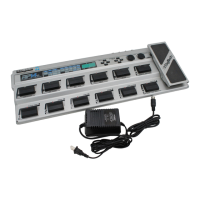Ambience, or reverberation, is produced when sound energy is reflected off room surfaces and objects. Using reverb in recorded program
material gives the listener a sense that the material is being performed in an actual room or hall. It is this similarity to actual acoustic spaces
that makes reverberation a useful tool in recorded music. Reverb Parameters and their functions are as follows:
Type Allows you to choose your ambience or setting you want to use. There are ten available type settings:
CLub=Club Garg=Garage
Stud=Studio HALL=Hall
bAth=Bathroom Chur=Church
pLat=Plate ArEn=Arena
Soun=Sound Stage SPrn=Spring
Level Controls the amount of reverb signal to be mixed in with the dry signal. Ranges from 0 to 100.
Decay Time The amount of time it takes for the Reverb to fade to inaudibility. Ranges from 1 to 10.
The RP14D includes a digital output which allows you to connect directly into a digital recording device or digital mixer without multiple
analog to digital, and digital to analog conversions. This maintains the integrity of your signal. The RP14D’s pre/post feature lets you select
where the digital output takes its signal from.
Pre/Post FX You can take the signal before or after the effects. The Pre setting taps the signal right after the Noise
Gate and Speaker Simulator. There would be no Mod/Pitch, Delay, or Reverb effects added to the signal
delivered to the digital output, but these effects will be heard at the analog outputs. The pOst setting
takes the signal from the end of all effects and delivers it to the digital output.
*Note: These Parameters can be assigned to the Expression Pedal. See page 11 for more information on Expression Pedal
assignments.

